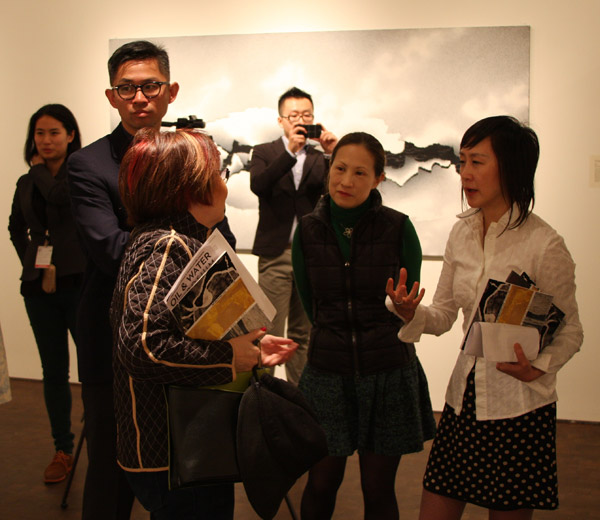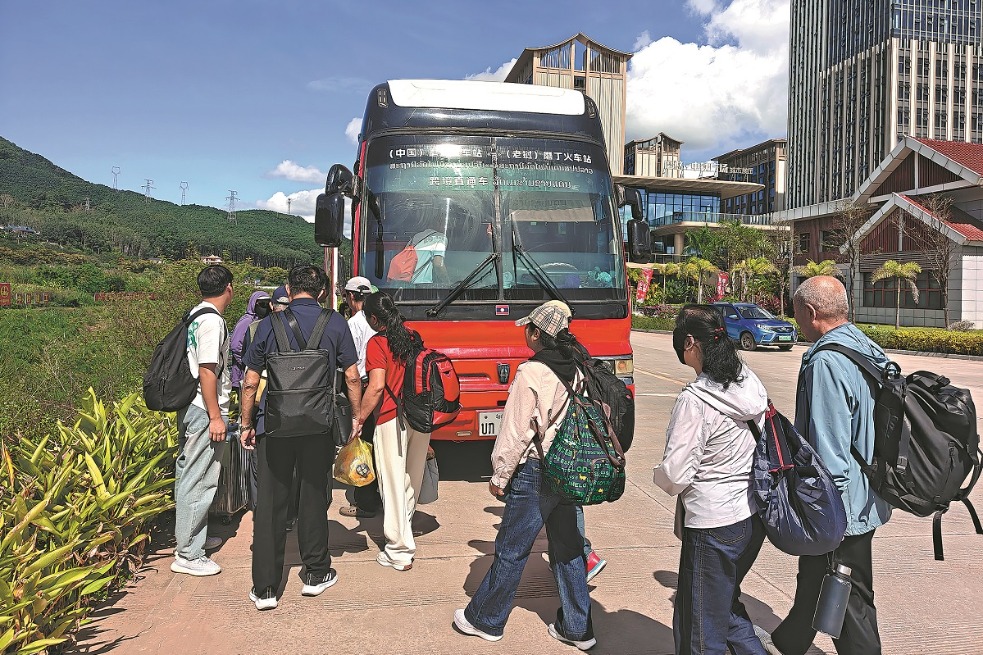MOCA set to open Chinese painting exhibit

Ink has long been a widely used medium in Chinese art, especially in calligraphy or poetry, but an exhibit at the Museum of Chinese in America (MOCA) is putting the focus squarely on Chinese ink paintings.
MOCA, in downtown Manhattan, will open an exhibit of contemporary Chinese ink paintings this week, and the guest curator for the installations said the display may cause visitors to rethink contemporary Chinese art.
 |
| Guest curator Michelle Y. Loh (right, in white) speaks with members of the press and other invited guests during a preview of an installation at the Museum of Chinese in America (MOCA) on Wednesday. The exhibit, Oil & Water: Reinterpreting Ink, juxtaposes the work of three Chinese ink painters with the hope of exploring the effects that contemporary art practices have had on the Chinese ink tradition. Jack Freifelder/China Daily |
Michelle Y Loh, the guest curator for Oil & Water: Reinterpreting Ink, said the exhibit spurs interest in contemporary Chinese art by promoting dialogues about the "influence of contemporary art practices on the Chinese ink tradition".
"The three artists in our exhibition are representative of a unique historical period," Loh said Wednesday in an interview with China Daily. "All three came to the US and devoted their energies to seeking and creating a visual language that reflects the intersection and collision between two sides — geopolitically between the US and China, and artistically between old, traditional mediums and new ones."
"By putting these works together in this exhibit, we are trying to revisit the idea of modern art through the lens of these artists," she said.
 |
| From left: Zhang Hongtu, a New York-based painter and installation artist; guest curator Michelle Y. Loh; Qiu Deshu, a Shanghai-based artist with a tendency toward fissure art; and Wei Jia, a painter with a penchant for works involving elements of Chinese calligraphy, pose for a photo at the Museum of Chinese in America (MOCA) on Wednesday. The three artists joined Loh for a preview of the museum's exhibit, Oil & Water: Reinterpreting Ink, which is set to open on April 24. Jack Freifelder/China Daily |
Oil & Water: Reinterpreting Ink, which juxtaposes the work of three contemporary Chinese artists — Qiu Deshu, Wei Jia and Zhang Hongtu — will be on display from April 24 through Sept 14.
In conjunction with the installation, MOCA will host outreach events to promote the exhibit, including family workshops on art made within the Chinese ink tradition.
At the end of the week, MOCA is also hosting a day-long conference on the traditional and cultural significance of Chinese ink art.
The event on April 27 will feature a number of art historians and art critics, as well as the curator and artists involved in Oil & Water.
Zhang Hongtu, a New York-based painter and installation artist, said people will understand more about Chinese contemporary art after visiting MOCA.
"From my 30 years over here in the US, some people are concerned that Chinese art is old and shouldn't even be put in a museum," Zhang said Wednesday in an interview with China Daily. "It depends on how you treat tradition and what's your perspective. Every tradition is still alive, even back to 1,000 years ago, even if not so many people respect the tradition today."
Wei Jia, a painter with a penchant for works that involve elements of Chinese calligraphy, said calligraphy has been an integral part of his maturation as an artist.
"When I was young I practiced calligraphy, but even still today I practice calligraphy for at least one hour every day," Wei said in an interview. "I practice calligraphy as self-cultivation, almost meditation even. It's like when you go to the gym to exercise, but the only difference is the body and mind."
Wei says the dilemma for a painter in a contemporary setting is the limitations that traditional painting techniques put on an artist and a work of art.
"I got a strong influence from studying calligraphy and Chinese painting when I was young, but I've been in America for 28 years," he said. There are two different influences in my painting; they show my experiences and what I thought every day."
To Wei, the label of "contemporary Chinese painter" is a misnomer.
"What I want to do is continue to explore Chinese traditional painting," Wei said. "But I have to challenge the traditional way of painting because it doesn't fit today. I don't use a Chinese brush and I try to avoid these ways because if I use Asian materials I will definitely be limited."
"I don't want to be labeled, so I just do what I love to do," he said.
Herb Tam, curator and director of exhibitions at MOCA, said "this exhibition is really a great lens for us to both see and work with these three artists."
Today's Top News
- Inclusivity critical for AI governance
- Massive response to latest bonds issue
- Control of precursor chemical exports tightened
- Xi greets Ouattara on reelection as Cote d'Ivoire president
- CIIE displays innovation, global confidence in China
- Nation set to sharpen focus on key sectors






























